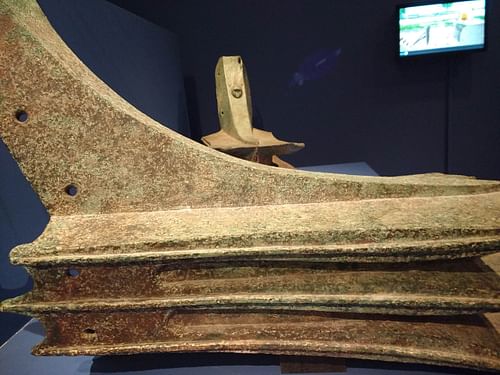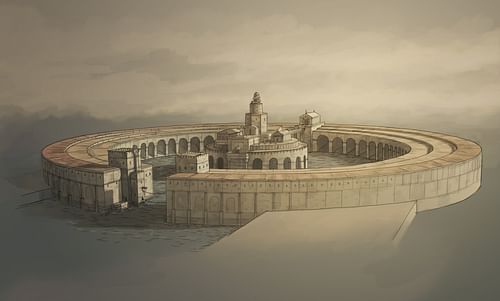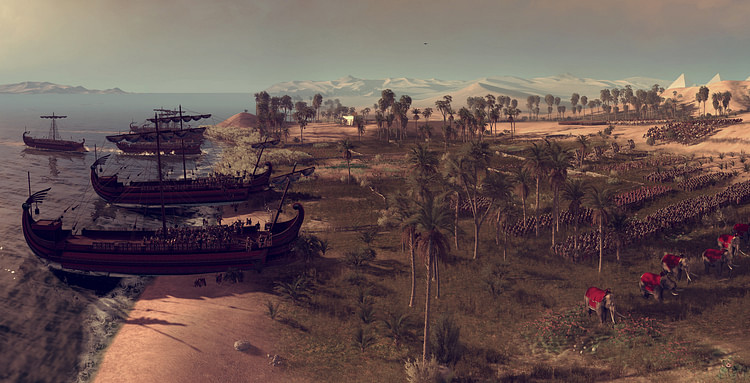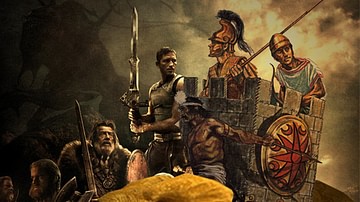
The Carthaginians were famed in antiquity for their seafaring skills and innovation in ship design. The empire their navy protected stretched from Sicily to the Atlantic coast of Africa. Able to match the tyrants of Sicily and the Hellenistic kingdoms Carthage's dominance of the seas would be challenged and ultimately replaced by the Romans, who were able to create a navy that became just as successful as their land army.
The Carthaginian Empire
Carthage took over the old Phoenician colonies in the Mediterranean and created many new ones so that its empire included North Africa, the Iberian peninsula, Sicily, Sardinia, Corsica, and many other islands. To maintain trade contacts between these cities and to police their interests the Carthaginians used a naval fleet which became the envy of the ancient world. Such was its strength that Rome, although successful in land battles, was forced to build its first ever fleet in order to defeat Carthage and claim the western Mediterranean for its own. For three centuries prior to the Punic Wars, though, the Carthaginian fleet ruled the waves.
Carthaginian Ships
Inheriting the skills passed on to them by the mother country Phoenicia the Carthaginians were admired across the ancient Mediterranean not only for their seamanship but also the quality of their ships. Such were the requirements of Carthage's large navy that ships were constructed using mass-produced pieces marked with numbers for ease of assembly. The wood used for ships was oak, fir, and pine. The size of the fleet changed depending on the period, but according to the ancient historian Polybius, Carthage had a fleet of 350 ships in 256 BCE. During the Punic Wars with Rome between 264 BCE and 146 BCE the fleet had to be constantly renewed to recover from losses in battles and storms.
The naval fleet of Carthage was composed of large warships propelled by sail and oars which were used to ram enemy vessels using a bronze ram mounted on the prow below the waterline. Direction was controlled by two steering-oars fixed to either side of the stern. Each oar was fitted with a horizontal bar for the helmsmen to handle. The Phoenicians had invented the trireme with three banks of rowers, but after using these in their early history the Carthaginians would later progress in the 4th century BCE to the bigger and faster ships with four and five men per oar, the quadrireme and quinquereme. The quinquereme, so called for its arrangement of five rowers per vertical line of three oars, became the most widely used in the Punic fleet. Catapults could be mounted on the deck of these large vessels but were probably limited to siege warfare and not used in ship-to-ship battles.
Tactics
The main aim in a naval battle was to ram and hole an enemy vessel or break its bank of oars. Sails were not used in battle conditions, but oar-power could give a ship a speed of 7-8 knots. Crews had to be well-trained to not only manoeuvre a ship as best as possible but also know when not to drive too far into an enemy ship and so become stuck when the ram impaled it. The second stage was to assault the enemy with missiles and, if necessary, board using grappling hooks and fight hand-to-hand. Polybius describes the skills and tactics of the Carthaginian navy in battle thus,
They much surpassed the Romans in speed, owing to the superior build of their ships and the better training of the rowers, as they had freely developed their line [formation] in the open sea. For if any ships found themselves hard pressed by the enemy it was easy for them, owing to their speed, to retreat safely to open water and from thence, fetching round on the ships that pursued…them, they either got in their rear or attacked them in the flank. As the enemy then had to turn round they found themselves in difficulty owing to the weight of the hulls and the poor oarsmanship of the crews, [so the Carthaginians] rammed them repeatedly and sunk many. (quoted in Salimbeti, 49)
Attempts to ram enemy ships could be made in two ways. The first, the diekplous or breakthrough, was when ships formed a single line and sailed right through the enemy lines at a selected weak point. The defending ships would try not to create any gaps in their formation and perhaps stagger their lines to counter the diekplous. The diekplous was used with great effect in 217 BCE by a Roman fleet to defeat the Carthaginians at the battle of Ebro. The second tactic, known as periplous, was to try and sail down the flanks of the enemy formation and attack from the sides and rear. This strategy could be countered by spreading one's ships as wide as possible but not too much so as to allow a diekplous attack. Positioning a fleet with one flank protected by a shoreline could also help counter a periplous manoeuvre, especially from a more numerous enemy. While all this chaotic ramming was going on, smaller vessels were used to haul stricken ships away from the battle lines or even to tow away captured vessels.
Aside from naval battles, the Carthaginian fleet was also vital for transporting armies, resupplying them by providing an escort for transport ships, coastal raids, attacking enemy supply ships, blockading enemy ports, and relieving Carthaginian forces when they were themselves besieged. The Carthaginian navy was also employed to sink trading vessels from rival states if they attempted to promote commercial activity in places Carthage considered it held a trade monopoly.
Commanders & Crew
Command of the navy was in the hands of an admiral selected by the council of Carthage. He had equal status to the commander of the land army, and only very rarely were the two forces commanded by the same person. Each ship was run by three officers, one of whom was the navigator. A typical quinquereme crew would have consisted of 300 rowers taken from the citizenry of Carthage and allied cities such as Utica. In later times slaves were also used to meet the high demands of warfare. The lesser-skilled slaves could be used to good effect in the larger ships where two men manipulated most of the oars. This arrangement allowed one skilled oarsman to guide the oar but also benefit from the power of the second man. The find of the Marsala shipwreck, a 3rd-century BCE Carthaginian naval vessel that sank off Sicily, revealed not only the labelled pieces of the ship's hull for easy assembly but also what the crew ate and drank: dried meat (poultry, horse, beef, goat, pork, and venison), almonds and walnuts, washed down with wine.
Oarsmen could not relax when beached as they were expected to fight in landing operations but not in ship-to-ship battles. Crews might also be employed in the building of siege engines, too. The larger ships were decked and would have carried complements of armed men, both archers and marines armed with spears, javelins, and swords, who could board enemy vessels given the opportunity.
The Harbour of Carthage
The Punic naval fleet had its own harbour separate from but connected to the merchant harbour at Carthage. The naval harbour was massive and circular whilst the merchant ships anchored in a rectangular one. Both ports were manmade, about two metres deep, and they possibly date to 220-210 BCE. The centre of the naval harbour was dominated by a tower structure known as the 'the admiral's island' which connected to the outer ring via a causeway. Appian gives an idea of the great size of the naval harbour by describing the central island's capacity for 30 ships and the 21-metre wide entrance. The outer ring of ship sheds could hold another 170 ships. From recent archaeology we now know that the harbour was 325 metres in diameter and matches Appian's description. The roofed sheds fronted by Ionic columns allowed the relatively light wooden ships to be pulled up a wooden slipway for repair and to avoid them becoming water-logged when not needed. The sheds were 30-48 metres long and 6 metres wide. The harbour also had a large platform (choma) which infantry and even chariots could use to board the ships. Both harbours were protected by massive fortification walls.
Key Sea Battles
The first known sea battle involving the Carthaginian navy was in 535 BCE against the Phocaeans off Corsica. Carthage's seemingly never-ending battle for control of Sicily produced many naval battles throughout the 5th and 4th centuries BCE with losses more or less equalling victories. Wars against Dionysius I of Syracuse (four), Timoleon, and Agathocles all saw naval engagements, blockades, and coastal raids. Carthage also provided its fleet for logistical support to the Romans in their war against Pyrrhus in the early 3rd century BCE. However, the best documented naval engagements, and those most vital to Carthage's survival, came during the Punic Wars with Rome now as enemy number one.
In the First Punic War (264 and 241 BCE) Rome quickly realised that to defeat Carthage they would have to do what they had never done before - build their own naval fleet. Accordingly, in the spring of 260 BCE, Rome constructed a fleet of 20 triremes and 100 quinquereme warships in only 60 days. Copying the design of a captured Carthaginian ship, the Romans then added a whole new feature: the corvus (raven). This was a rotating 11-metre long platform with a giant holding spike (like a beak, hence the bird name) which could be lowered onto an enemy vessel to allow a heavy infantry unit (perhaps 80-120 men) to board them. The idea would negate the superior seamanship of the Carthaginians and make naval combat more like a land battle. This masterstroke of inventiveness was an immediate success when their fleet of 145 ships defeated the Carthaginian fleet of 130 ships at the battle of Mylae (Milazzo) in 260 BCE. The Carthaginians, so dismissive of their opponent's seafaring skills, had not even bothered to form battle lines. When the Carthaginian flagship was captured, the commander was forced to flee in a rowing boat. The Roman commander Duilius was honoured with a Roman triumph, the first in Rome's history to be awarded for a naval victory.
Carthage seemed to have no answer to the corvus and more defeats came at Sulcis in 258 BCE and in the battle of Ecnomus in 256 BCE. The latter was one of the largest naval engagements in history with the Romans commanding 330 ships and the Carthaginians a similar number. The Romans formed four distinct battle groups which disrupted the Carthaginian lines. 100 of the enemy ships were destroyed compared to 24 Roman losses.
Carthage fought back in 249 BCE with an important victory at Drepana (Trapani) where their superior seamanship saw them outmanoeuvre the Roman fleet out at sea. The Carthaginian fleet was ably led by Adherbal who captured 93 of the 120 enemy ships. The Roman commander, Publius Claudius Pulcher, who had rashly decided to attack at night, was tried for treason back in Rome. Round one of the Punic Wars was finally won by the Romans with their victory off the Aegates Islands (Isole Egadi) on 10th March, 241 BCE. The Carthaginian fleet, led by Hanno and sent to relieve the besieged city of Drepana on Sicily, was defeated by a 200-ship Roman fleet commanded by the consul Gaius Lutatius Catulus. Catulus had spent all the previous summer training his crews and the effort paid off when 50 Carthaginian ships were sunk, 70 captured, and 10,000 prisoners taken. This loss was not huge, but after decades of war, it drove the cash-strapped Carthaginians to seek peace terms.
The Second Punic War (218-201 BCE) was largely fought on land, but the fleets of both sides were crucial in transporting land armies, resupplying them, and blockading ports throughout the conflict. Hamilcar Barca had already sailed in 237 BCE with an army to conquer much of southern Spain. In 216 BCE the fleet was used to transport an army to Sardinia in a failed attempt to take back the island and another army to Spain to relieve the pressure from Scipio Africanus the Elder. In 213 BCE an army was transported to Sicily, but again the Carthaginians could not prevent Marcellus from taking Syracuse. In 205 BCE Carthage sent yet another army, led by Mago, to relieve his brother Hannibal who was by now cornered in southern Italy. Unfortunately, they could only land in Liguria, northern Italy because of the Roman naval dominance and their control of the major ports further south. In 204 BCE Scipio managed to cross to Africa unimpeded with an army of 30,000 men. In 202 BCE the Roman general then defeated an army led by Hannibal at the Battle of Zama. The second and most decisive round was over with Rome once again the victor.
Land battles had been decisive in the war but so too had Carthage's lack of naval dominance. Crucially, Carthage had not been able to resupply Hannibal, join the armies of the two brothers together, or prevent Scipio from landing in Africa. The Roman dominance of the seas following the First Punic War had made them unstoppable. Part of the peace terms after the Second Punic War stipulated that Carthage could never again possess a fleet and the once great navy was limited to a paltry 10 ships.
The Third Punic War (149-146 BCE) turned out to be something of a mismatch. Carthage, without a navy, could do nothing to prevent the Romans landing an army of over 80,000 men in North Africa. Despite valiant resistance behind Carthage's impressive fortifications and a brave attempt to break the siege with a fleet of 50 secretly constructed ships, Rome was able to carry out the senator Cato's famous command to the letter, Carthage was destroyed. Rome had lost 600 ships in the Punic Wars (most of those due to storms) and more men than its opponent but its ability to replace them and the superiority of the land army meant Carthage was not only defeated time and again but the city obliterated and the population sold into slavery.
Conclusion
The Carthaginian navy had initially been the Mediterranean's innovators in ship design and they had enjoyed many victories against multiple enemies but by the time of the Punic Wars the world had changed. Very few ancient wars up to that time were ever settled by sea engagements alone as land warfare remained the principal means to inflict total defeat on the enemy. Even before the Punic Wars had started, Carthage had gone a generation without having to fight a naval battle with the consequence that its mariners had little real battle experience. Rome took up naval warfare with great success and displayed an astounding ability to replace its fleets almost at will. In Spain and North Africa Romans defeated the Carthaginian armies on land. Hannibal's four great victories in Italy proved to be the exception, not the rule, and his gamble that Rome would collapse from within failed. Thus, Rome, with its professional army and navy of highly-trained and well-disciplined troops led by a clear command structure lusting for military glory within their term of office, swept aside Carthage both on land and at sea. Carthage was not helped by overly-conservative commanders but, in any case, it simply did not have the military or financial means to compete with the Mediterranean's new superpower. Ancient warfare had evolved into a multi-weapon, multi-trooped, and multiple theatre activity at which the Romans excelled above all others.








